Paddock Practices: Key considerations before deep ripping sandy soils
Paddock Practices: Key considerations before deep ripping sandy soils
Date: 01 Apr 2019
Key points
- Deep ripping compacted or hard-set soils has been shown to improve grain yields, particularly on sandy soils
- Use tools and techniques to identify hard and compacted layers
- Yield benefits to ripping may be limited where existing constraints, such as subsurface acidity, are not addressed
- Most ripping practices do not provide enough surface mixing to overcome water repellency for multiple seasons
- Getting the timing right for deep ripping will ensure effective outcomes, minimise running costs, wear and tear, and avoid costly mistakes
- Combining higher speed with narrower machines, rather than lower speed with wider machines, can help protect the tractor transmission
- Post-ripping trafficability and seeder performance can be improved by orientating rip-lines at an angle to sprayer tracks and seeding directions
- Feed the crop to realise its higher yield potential
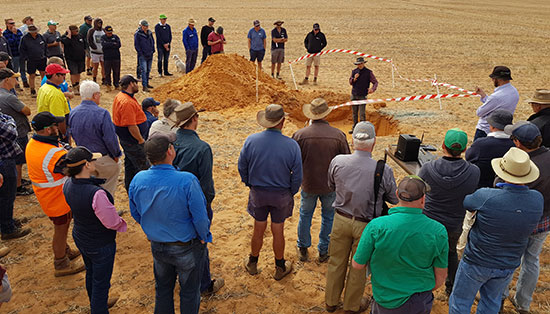
A renewed interest in the practice of deep ripping has prompted calls from researchers for growers to familiarise themselves with some of the key considerations for ripping on sandy soils.
Deep ripping of compacted soils is most likely to improve grain yields on sandy soils and where compaction has occurred on upper parts of the soil profile through machinery traffic or livestock trampling.
CSIRO senior research scientist Dr Lynne Macdonald says the aim of deep ripping sandy soils is to remove physical constraints to root growth which result from compaction due to machinery trafficking, animal trampling, or cementing due to drying.
“Ripping shatters hard or compacted layers to allow greater rooting depth and improve access to deeper profile moisture,” she says.
“However, ripping alone does not fully address other soil constraints such as acidity, subsurface toxicities, or non-wetting characteristics.”
Dr Macdonald says it is important to identify and prioritise key constraints on sandy soils. While this may be difficult, assessing where crop roots stop growing can be a useful indicator of the depth of relevant constraints.
“It is important to look beyond the depth of rooting and consider issues that might be present deeper in the profile,” Dr Macdonald says.
“It is important to target ripping practices to those sands where hard or compacted layers are the primary issue.”
“Where acidity, water repellence, or subsoil toxicity are primary constraints, other amelioration practices may also be needed for the full benefits from ripping to be achieved.”
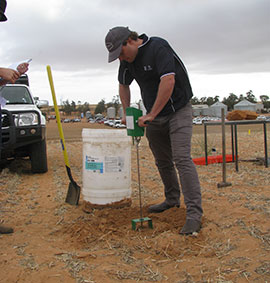
Identifying layers
Digging a soil pit enables growers and advisers to look and feel for changes in soil structure, particularly hard and compacted layers.
This will help them to target the ripping depth to either go past, or at least well into, the compacted layer and maximise rooting depth.
Push probes and penetrometers are other options for identifying hard and compacted layers, with more information available on the Soil Quality website.
Dr Macdonald says soil moisture will have a big impact on how hard the soil will feel, with most soils hardening on drying.
“Push probes and penetrometers should be used after significant rain when the soil moisture profile is full,” she says.
“This will help to avoid misleading penetrometer readings caused by lack of moisture alone. The depth of hard and compacted layers varies across the sandy soil landscape.
“Ripping to depths deeper than necessary is very costly due to fuel requirements - for example, doubling the depth may quadruple the power needed.
“It is important to look beyond the depth of rooting to identify how deep the physical constraint continues.”
Subsoil acidity
Acid layers can occur in a relatively thin zone that prevents root growth, and can be missed by traditional 0-10-centimetre soil sampling.
Acidity-related constraints can stunt root growth, limit nutrient availability, or lead to toxicity effects. The full yield benefits of ripping are unlikely to be achieved if subsoil acidity goes untreated. Threshold levels for soil pH (in water) are above 5.5 in the top 10 cm, and above 4.8 in the subsurface soil.
Dr Macdonald says yield benefits to ripping alone may be limited where subsurface acidity constraints are not addressed.
“Applying pH indicator dyes - which can be readily bought from hardware or gardening stores - can be an effective first step in identifying if there is an acid problem and where in the profile it occurs,” she says.
However, laboratory soil pH tests are more accurate.
“Where pH falls below the threshold targets, a liming plan should be part of a long-term amelioration strategy.”
More broadly, Dr Macdonald says subsoil toxicities and nutrient deficiencies are common in sandy soils of the southern cropping region.
“A subsoil health check can be useful in avoiding areas where deeper rooting depth may not bring yield returns due to subsoil toxicities,” she says.
“Diagnosing subsoil issues involves assessing pH, electrical conductivity, exchangeable sodium, boron, or chloride and essential plant nutrients and various packages are offered from commercial laboratories.”
Water repellency
Although providing some surface disruption in the year of implementation, most ripping practices do not provide enough surface mixing to overcome water repellency for multiple years.
Rather than ripping alone, repellency is better addressed through deep ploughing approaches that mix the repellent sand to dilute and/or bury the problem layer, Dr Macdonald says.
“Where available, the addition of clay can provide a permanent solution to overcoming water repellency,” she says.
“Specific delving and mixing tine designs are required to effectively mix the surface soil layers and can be applied with or without claying practices to overcome water repellency.
“If repellency is not overcome, the full yield benefits of ripping are unlikely to be achieved as issues of water infiltration, crop establishment, and erosion risks will remain.”
The Eckert family, Malinong, SA, and their agronomist Matt Howell, Platinum Ag Services - Coorong, have been experimenting with the Plozza Plough to improve non-wetting sands which has resulted in yield gains.
Timing and moisture
Getting the timing right for deep ripping will ensure effective outcomes, minimise running costs, wear and tear, and avoid costly mistakes.
University of South Australia Agricultural Research Engineer Dr Jack Desbiolles says test strips are valuable in understanding the specific interactions between soil and specific machinery.
“Soil moisture conditions are important for optimal crop establishment and cost of operation,” he says.
“Ripping a dry profile will require greater power, and wear and tear, and can lead to a rough surface soil with large clods. When the profile is too wet, the ripping tines are at risk of operating below their critical depth, especially in heavier soil textures.
“This will drastically limit the extent of profile loosening, substantially increase draft, and create localised subsoil compaction around the tine foot.”
Machinery set-up
Dr Desbiolles says ripper tine spacing can be optimised to maximise soil loosening and minimise draft.
There is a maximum tine spacing at any given depth, which should not be exceeded to completely loosen the soil and leave a smooth surface.
The table below provides a general guide for setting up ripper tine spacing, while the optimum spacing can vary depending on tine design, soil type and condition, presence/absence of leading shallow tines, and the full depth of ripping. Leading shallow ripping tines should be located at a minimum distance ahead of greater than 1.5 times the full depth of deep ripping.
| Deep subsoiler tine | Leading shallow ripping tines | Deep subsoiler tine spacing | Notes |
|---|---|---|---|
| Conventional straight tine | None | 1.0-1.5 x depth | Tines must be operated above their critical depth. |
| Located in-line | Up to 1.0 x depth | Leading shallow ripping tines operating at 40-60% of the full ripping depth. | |
| Winged tine | None | 1.5-2.0 x depth | For example, wings extending to 300mm overall width. |
| Located in-between | Up to 2.5 x depth | Leading shallow ripping tines operating at 60% of the full ripping depth. |
“Very significant increases in the extent of soil disturbance can be achieved through the use of wings and leading shallow tines located in between,” Dr Desbiolles said.
“This results in much greater energy efficiency as measured by the specific resistance (draft per unit of loosened profile area), and often means a lower draft requirement per unit width of the deep ripper.
“The design of the ripping tine can vary and affect the proportion of sub-layer loosening, mixing or re-arrangement and delving, all of which can influence the surface finish and exposure to wind erosion.
“Slanted or bent leg designs are the most effective at fracturing soil profiles with the least re-arrangement and facilitate a smooth surface finish.
“Delving or mixing tines used at higher speeds may have advantages where constrained soil layers can be diluted into beneficial layers, but at the cost of high surface disturbance and erosion risks until a follow-up crop is established.”
Inclusion plate research
As part of the Agricultural Machinery Research team at the University of South Australia, Drs Chris Saunders and Mustafa Ucgul are using computer simulation techniques to model soil-machinery interactions for deep tillage implements such as spaders, ploughs and rippers.
They are closely collaborating with WA researchers on improving the understanding of the mechanics of top-soil inclusion (PDF, 804KB).
“Inclusion plates are used with ripping tines when the aim is to incorporate topsoil and/or amendments down into the profile,” Dr Saunders says.
“Inclusion plates allow topsoil to fall down the slot following the ripping tines, a technique sometimes referred to as topsoil slotting. Topsoil inclusion should be conducted in dry and free-flowing soil conditions for best results.”
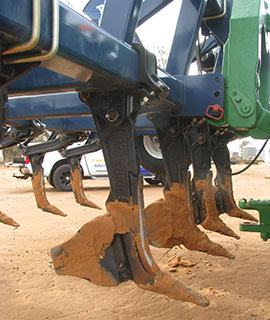
Recent research in WA showed that the addition of inclusion plates significantly increases the surface disturbance and draft requirement of deep ripping.
“The computer simulations are adding value by developing an understanding of how to best optimise performance and minimise cost,” Dr Saunders says.
“These are complemented by field validation work.”
Safety, hitching and machinery protection
When selecting a deep ripper technology, Dr Desbiolles says it is important to match the required shear-pin capacity, consider if a non-stop hydraulic protection is warranted and ensure the required jump height capacity can be achieved without clashing.
He says correct hitching of the ripper is also important.
“If the ripper is hitched to a three-point linkage system, the top and lower links should aim for a far forward convergence point, or near horizontal in the work position, to ensure good penetration capacity,” he says.
“Growers should check the ripper is operating level and equally across its width.
“When utilising full tractor power, combining higher speed with narrower machines, rather than lower speed with wider machines will minimise torque requirements and protect the transmission.
“Some areas of the subsoil environment may lead to impact damage, so it is important to slow down where required.
“Check the soil upheave is not constrained by lack of frame clearance, especially in high residue conditions.
“The use of residue cutting coulters may be required under some weedy or high residue conditions.”
Assessment and post-ripping
Dr Desbiolles advises checking the ripping impact by assessing the uniformity of the ripping depth on and off the rip line with a push probe rod, or by digging a profile face to visually inspect the extent of the profile loosening achieved.
“Inter-rip shattering with conventional tines may be improved by increasing ripping depth, provided tines are not operating below their critical depth, which is the depth below which the tine foot becomes unable to sufficiently lift and loosen the soil profile,” he says.
“This situation results in localised compaction created by the foot and creates a significant draft penalty.
“Tines must always be operated above their critical depth to minimise power requirements. This is a real issue with the emerging trend of exploring ripping to 60 centimetres or deeper.
“Wider and higher-lift foot dimensions, as well as wing attachments, can significantly reduce the risk of operating below critical depth.
“A foot located well forward of the shank - such as a parabolic shank - rather than at the bottom of a vertical shank, can be at greater risk of operating below critical depth.
“A profile face inspection is the best way to confirm the loosening efficacy of a particular tine design and layout.”
Seedbed finish is important for good crop establishment following ripping which may be hampered by large clod sizes and loose packing.
A key step is to aim for a level finish after ripping, which is achieved when full profile loosening and soil layer re-arrangement is evenly achieved across the ripper.
This is achieved using low disturbance or non-mixing tine designs with an optimised layout, followed by surface firming where needed using a consolidation roller.
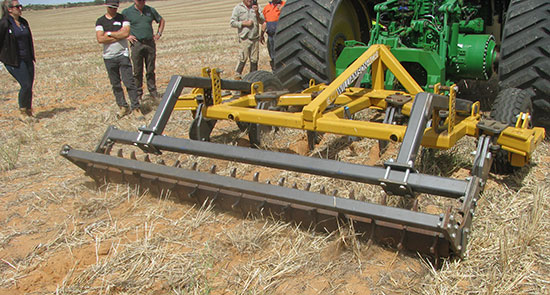
There are a number of options for managing excessive clod size:
- Delay ripping operations until soil moisture improves
- Use a gradual ripping approach over two passes or a pre-rip cultivation
- Consider using shallow leading tine ripper designs
- Use optional clod-breaker or crumbler roller attachments.
“Post-ripping trafficability and seeder performance can be improved by orientating rip-lines at an angle to sprayer tracks and seeding directions,” Dr Desbiolles says.
“It is important to develop a plan to manage trafficability following ripping.
“Trafficability will be reduced following ripping and the ripped area will not carry heavy vehicles as well as it did before ripping.
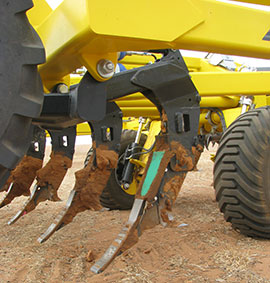
“Controlled-traffic farming can help avoid trafficking issues.
“Un-ripped permanent wheel tracks will allow heavy vehicles to travel across the ripped areas without any impediment.”
Rolling post-ripping will help consolidate the surface and lessen the risk of wind erosion, however, lack of standing stubble may still leave the site vulnerable.
Crop nutrition
An important consideration for growers is to make sure the crop has the opportunity to reach its newly-realised yield potential by providing it the right nutrition.
“A successful ripping operation is likely to increase the potential of crops and pastures for several years,” Dr Macdonald says.
“Management of ripped areas should be adjusted to match the new potential yield.
“For example, without higher nitrogen inputs, the crop yields may not fully respond to the benefits from deep ripping.”
GRDC investment
The GRDC investment, Increasing production on sandy soils in low and medium rainfall areas of the southern region, is exploring cost-effective techniques to diagnose and overcome the primary constraints to poor crop water use on about five million hectares of under-performing sandy soils in the southern region.
The study is a collaborative effort involving CSIRO, Primary Industries and Regions South Australia, the University of South Australia, Mallee Sustainable Farming, Ag Grow Agronomy and Trengove Consulting.
More information
Contacts
Dr Lynne Macdonald, CSIRO, 08 8273 8111, lynne.macdonald@csiro.au
Dr Jack Desbiolles, UniSA, 08 8302 3946, jacky.desbiolles@unisa.edu.au
Dr Chris Saunders, UniSA, 08 8302 3664, chris.saunders@unisa.edu.au
